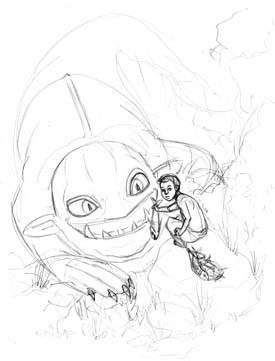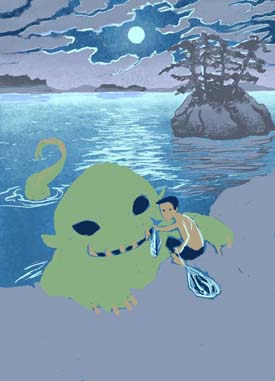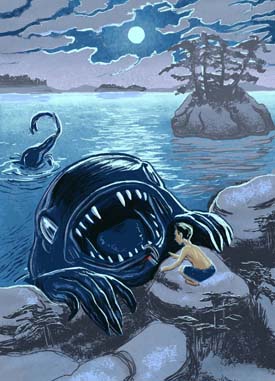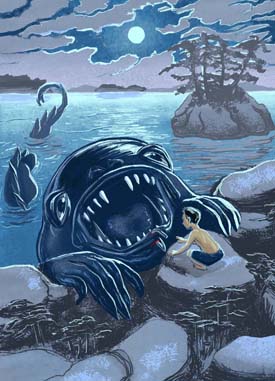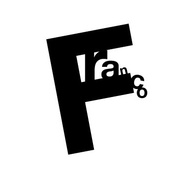This interview was conducted on March 20, 2015, via instant message. The text has been minimally edited for concision.
Tami Lawless (Strangelet): So, I have about 10 questions that I would like to ask you for the interview (I may or may not ask follow-ups). If either of us need to douse any fires or anything of that nature, we can certainly come back to it easily enough.
Tory Hoke: Heard and understood.
Tami: Shall we begin?
Tory: I’m in a state of catlike readiness.
Tami: Excellent. Prepare to pounce:
Tory: Hehehe.
Tami: Starting out with something simple, when did you know you wanted to be an illustrator? What put you on that path?
Tory: Ooh, interesting. Since I was a little kid, I drew things. I mean, that’s a little insipid to say because every kid draws things. I think most people that end up drawing showed some kind of aptitude early, and got encouraged. That’s all it takes, I think. Not to get philosophical, but it’s natural to draw, especially when you’re a little kid and you don’t necessarily have words for everything you’re trying to show. Drawing is cheap. It’s portable. Wherever you go, whatever you do, you can doodle in the margins, you know? I sort of want to push across to people that anybody can draw. Anyone who wants to can and should! It’s a mean cheat that happens to little kids, that some get told they can, and some get told they can’t, and so they stop. That’s sort of tangential, but I guess the point is, I draw because I never quit drawing.
Tami: Do you think your drawing was a catalyst to writing?
Tory: Maybe so! It definitely preceded it. I’ve definitely got this thing of wanting to tell stories, not caring particularly how the stories come out, whether it’s an illustration or a short story or a comic strip or an animated short. Frankly, I could stand to put a little more planning in before I launch into things. It turns out that the cover art type illustrating I do—like River Baby—is the fastest way to get an idea out. Writing takes longer. A comic book is worse. Animation—woof.
Tami: What was the inspiration behind River Baby? Did you have a story in mind that you wanted to convey for that piece?
Tory: Good question. Let me think. I think I was on a friendly monster kick. Also I wanted to learn how to do moonlight behind clouds—or maybe I was going through some reference photos and saw a moon I liked. So if you’ve got a friendly monster out at night, well, that’s a monster with a problem. Oh! It was definitely inspired by—hang on, I’ve got to look up the name of this thing. An Atlantic Glaucus!
Tami: Oh I’ve seen those! They are adorable.
Tory: Yes!
Tami: As is river baby! I can see it.
Tory: Haha! Rad!
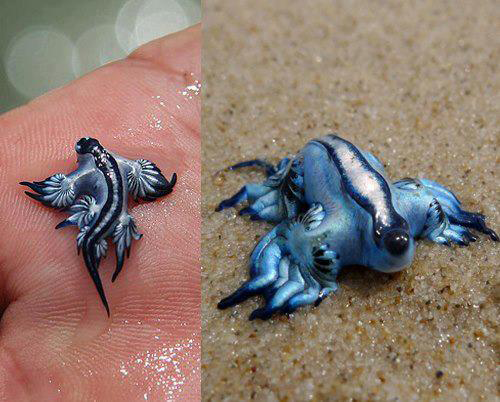
The Atlantic Glaucus, via Wikimedia Commons
Seriously, how cute is that thing! So I totally failed to nail the iridescent thing about it. But the great thing about drawing is you can kind of take the money and run. Cannot do that writing. Cannot.
Tami: That’s a fact.
Tory: Haha! “Huh, this scene totally isn’t doing what I hoped. Oh well!” Oh! I think I have preliminary drawings, too.
Tami: I would love to see the infant stages! It’s always interesting to see the process involved in great artwork.
Tory: Original sketch
Tory: Decided the creature looked too cute. Also spouse raised story questions—where did the kid get the fish? Why can’t the creature fend for itself?
Tory: Atlantic Glaucus inspired, different story point. Fish eyes turned out not to be what I was going for. Experimenting with city lights in deep background.
Tory: Different eyes. Went back and forth on nostrils. Ended up going for it. Wasn’t satisfied with city lights so omitted them. Also turned the hook around to be more consistent with how hooks actually get stuck in things.
Tami: This is slightly off-topic, but did you see the credits of the third Hobbit movie? It was all of the concept art for the entire production. Breathtaking.
Tory: Yes! So good!
Tami: Agreed! Okay, back on topic. You recently became the Art Director for Strange Horizons. What has that experience been like for you?
Tory: Oh man! It’s been really, really rewarding. It feels like I tripped and fell upward somehow. It’s been a hell of an education seeing the art commission process from the other side. And a hell of a treat getting to work with the Strange Horizons staff. Heather McDougal is my Co-Art Director, and we split some duties and share others. She brings more from the writer and graphic design angles. Working with her has been a pleasure and a force multiplier. I’m very grateful to be aboard SH—and maybe still a little shocked.
Tami: It sounds like a great fit for your talents. In looking through your portfolio, we had the opportunity to play a couple of your interactive fiction games, which led us to your site for sub-Q. What inspired you to start a literary magazine for interactive fiction?
Tory: Ooh! If you found sub-Q, you may be the very first!
Tami: Well lucky us!
Tory: Haha! Man, I am going to have to hold my own reins here to keep from keeping you here all night. Interactive fiction is super my main point of interest right now. I’m convinced IF is going to go supernova any day. Everything is in place. The technology is there. [The creative stars are there—Porpentine, Javy Gwaltney, Michael Lutz.] The devices are there. The audience is ready. Imagine a Princess Bride where you get to romance Inigo. That is coming! I look at the Dragon Age fandom—hell, any of the Bioware fandoms—and all these players living and loving the hell out of the story. I myself play the Dragon Age series as a dating sim with RPG mini games. I look at author-insert fiction—not just romance, which of course is crazy-go-nuts popular and in-demand, but also urban fantasy, superhero fantasy, any kind of fantasy—that’s what fantasy’s for. Imagine a serialized novel that starts with character configuration, more or less. Maximize audience investment. Maximize audience addiction. Stab an adrenaline plunger in the heart of the fiction industry. That can happen. That will happen. If I build the platform it happens on, fantastic. But no matter what, when the day comes that I get to read, write, and share this kind of stuff, I’ll be thrilled out of my mind. There’s more to say but I’ll come up for air now.
Tami: I tend to agree. We all love that kind of thing at Strangelet, and I don’t see it going anywhere but up. Just a few more questions for the night.
Tory: Sure thing, and psyched to hear you feel it in your bones, too.
Tami: Do you feel like you have a responsibility to make sure your art stays progressive? Are you trying to make a statement with your diversity? What is that statement?
Tory: Ooh. Yes and no. And yes. What I tend to say is that if I’m putting my work out there, promoting myself and taking up bandwidth, I have a responsibility to make my work reflect the people that are stuck looking at it. There are a lot of people who could go to my portfolio and not see themselves reflected. I’ve got to keep them in mind. Another thing, it’s very easy to find occasions to draw white people. I noticed this when I was doing my vocabulary comic. Every weekday I’d use a rare word in a sentence and illustrate it. I’m white. If I draw myself, that’s a white person. My cultural references skew white. If I draw Tolkien, that’s a white person. So if I don’t pay attention to what I’m doing, things get really white. There’s more to diversity than race, of course. I’ve got to keep my mind on that. But not every human figure I draw will communicate a gender, sexual preference, or level of physical ability. Every human figure will have a color. Well, unless I’m getting into some body horror.
Tami: I think that’s a noble effort. What does your dream project look like? The thing you would most love to work on.
Tory: I think, with sub-Q, I’m actually doing my dream project. A platform for interactive fiction, that is. What I’d like to do is get that going, get it healthy, get it sustainable. Put it in the hands of people smarter than me. And step back to write a serialized IF novel—sci-fi or fantasy, with romance options, natch. I want to make people feel about a character the way I felt about Alistair in Dragon Age: Origins. That is the highest creative achievement I can think of. Then I will be ready to greet our robot overlords.
Tami: That is a day we all wait patiently for.
Tory: Haha!
Tami: Okay, last question: Where do you see your art and storytelling going in the future? Specifically, what progress do you hope to achieve?
Tory: For my drawing, I’d like to get better at choosing colors. I’d like a stronger painterly style. I’d like a better understanding of depicting light and atmosphere. This could be a really long list, so I’ll stop. For my writing, well, just today a friend shared a piece with me and—OK, how can I say this? Eddie Vedder in an interview said he started out wanting to play guitar, but after he tried it, he heard Jimi Hendrix, and he knew he was never going to be Jimi Hendrix. This friend, his work, he’s like Jimi Hendrix. And I know I’m never going to be that good. But you know what? Sometimes Eddie Vedder still plays guitar. Maybe a little ukulele. You just gotta play.
Tami: Indeed! Well, I wish you the best of luck with your sub-Q project! And we are honored to feature River Baby as our cover for Issue 1. Thank you so much for your time and engagement.
Tory: Thank you for having me, Tami. It’s been an honor and a treat. Thank you for the kind words, and keep up the great, weird work with Strangelet!

